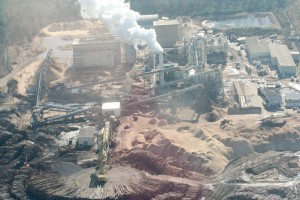
Aerial shot of Enviva wood pelleting plant in Ahoskie, N.C., a facility similar, according to Emily Zucchino of Dogwood Alliance, to the plant proposed in Winnsboro. (Photo/Dogwood Alliance)
WINNSBORO (Oct. 30, 2015) – A proposed wood pelleting facility ran into its second snag Monday night in its bid to construct a plant on more than 180 acres it plans to purchase on Cason Road, and this time it wasn’t because of the weather.
Record rains and flooding scrubbed County Council’s slated first reading on Oct. 5 of an ordinance to rezone two parcels for AEC Pellet 1 USA from RD (Rural Resource District) to I-1 (Industrial District). Although Council finally got first reading in during their Oct. 12 meeting, Monday night a different kind of storm disrupted the process.
“This company is going to get tax breaks out the ying-yang,” Darryl Harbour told Council during Monday’s public hearing on the rezoning proposal. “We, however, are probably not going to get any tax breaks, even though our home values are fixing to plummet, our land values are fixing to plummet.”
Harbour was one of 10 neighboring landowners who signed up to speak out against the ordinance that would rezone 2.01 acres owned by Rosezenna Cason White at 137 Cason Road, and 180 acres owned by Wateree Holdings LLC c/o Forest Investment Associates also on Cason Road.
“For them to say they’re coming in here and investing $125 million, that is false,” Harbour said. “They are going to build a building. They are going to buy land. They’re going to buy a huge investment in equipment and that equipment is going to be made overseas. That’s where the millions of dollars of money is going to be going. And then it will be transported over here, put into effect and we get to live with the results of it.”
According to documents on file with the S.C. Department of Health and Environmental Control (DHEC), the facility would have an annual production rate of 530,000 tons, with a minimum hourly production rate of 71 tons.
“Breaking that down in sheer weight alone,” Harbour said, “that would be 26,500 truckloads up and down the highways in Winnsboro a year.”
Rail traffic also presents a problem, he said, in a community accessed by one-way streets.
“They plan to unload 22 cars,” Harbour said. “Twenty-two railcars at 60-feet long is about 1,300-feet long. We’re used to that railroad car zooming through; it’s going to be a whole different ballgame when they come to a screeching stop and start transferring 22 cars at a time. If you happen to be someone back in the neighborhood trying to get physical help, having a heart attack, that ambulance comes and you ask that train that’s at least 3,000-feet long to hurry up and move out of your way – it’s not going to happen.”
Council announced the tentative arrival of AEC Pellet 1 during their Aug. 24 meeting, when they also passed third reading and disclosed the details of the company’s incentives package.
Interim County Administrator Milton Pope said during the Aug. 24 meeting that the terms of the Fee-in-Lieu-of-Taxes (FILOT) agreement included a $125 million investment by the company, as well as the creation of 75 new full-time jobs. AEC Pellet will be assessed at a ratio of 6 percent, Pope said, and will pay a fixed millage rate of 423.3 mills for their first 30 years. They will also receive a special source revenue credit of 60 percent per year for the first 10 years.
But in 10 years, there may be no market for what AEC Pellet 1 produces, according to Emily Zucchino, a campaign organizer with the Asheville, N.C. environmental advocacy firm Dogwood Alliance.
“This market is based on European policies, which we know with working with policy makers in Europe will change in the next 10 years,” Zucchino told Council. “The wood pellet industry is an extractive export market to feed power plants in Europe, and is in a transitional market until these power plants switch to wind and solar. So my question for you is what happens to Winnsboro in 10 years when there are no longer subsidies in the market for these wood pellet facilities?”
Pollution is also a concern with wood pelleting plants, Zucchino said, with facilities generating fine particulate matter into the atmosphere. In N.C., she said, communities living near similar facilities have seen increases in respiratory illnesses, bronchitis and asthma.
According to DHEC documents, and as first reported in The Voice on Aug. 29, emissions generated by the facility would include particulate matter (less than 10 micrometers in diameter and less than 2.5 micrometers in diameter), nitrogen oxides, carbon monoxide, sulfur dioxide, Volatile Organic Compounds (VOC) and Hazardous Air Pollutants (HAP). The notice states, “a federally enforceable facility-wide limit of less than 250 tons per year” of the particulate matters, the carbon monoxide and VOC “would be established, thereby enabling the facility to be below Prevention of Significant Deterioration (PSD) major source thresholds.”
Federally enforceable limits of 10 tons per year would also be established “of any single HAP, or less than 25 (tons per year) of total HAPs,” the documents state.
An air quality permit (permit number 1000-0039-CA) was issued to AEC Pellet on March 16, DHEC said.
“I have asthma,” area resident Sylvia Beaver told Council. “I have all kinds of health problems. If they block the railroad, I can’t get out if I’m having an asthma attack or any other kind of health issues.”
Kerry Matthews, who lives near the proposed plant site in White Oak, said the factory would destroy the rural residential character of the community.
“We have set up zoning regulations particularly for this reason, to protect the rural areas and communities,” Matthews said, “and it is unconscionable to me that anyone would consider putting a plant with this magnitude impact on a community in an area like White Oak. Fairfield County has industrial parks.”
Toatley Road resident Robert W. Davis said Fairfield County can afford to be more selective about what kind of industry it brings into the county.
“Don’t get me wrong; we are for economic development,” Davis said, “but Fairfield County is in a position whereby we don’t have to accept anything and everything that comes along just because they say they’re going to bring economic development to Fairfield County.
“Over the next year and a half to two years, we are going to have funds coming into this county from the western side of Fairfield County,” Davis continued. “Those funds will be more than enough to sustain Fairfield County for years to come. What this will do is hurt our community. Hurt is greatly.”
When second reading finally came to the floor, Council gave it a unanimous approval – but not without strings attached.
“The citizenry that has talked to me, some are for it some are against it,” District 3 Councilman Walter Larry Stewart said. “But we need more detailed information concerning the air quality and all the other issues citizens from District 3 have raised tonight. I think we need to delay the process, collect the rest of the data and allow the citizens to give any additional input and then move forward.”
Pope recommended that Council pass second reading, but delay third and final reading until additional information could be collected from Zucchino and area residents. Pope also suggested another public hearing on the matter.
While Stewart and Mary Lynn Kinley (District 6) also suggested the possibility of a work session, District 7 Councilman Billy Smith’s motion to officially include a work session into the process failed to garner a second.











